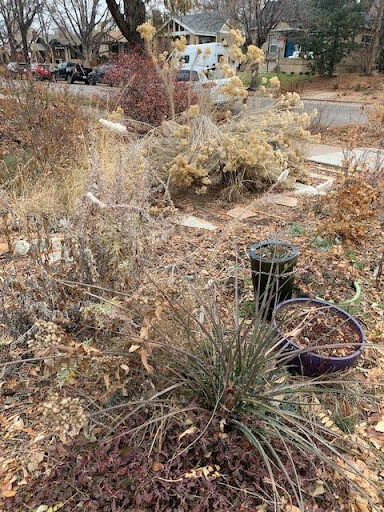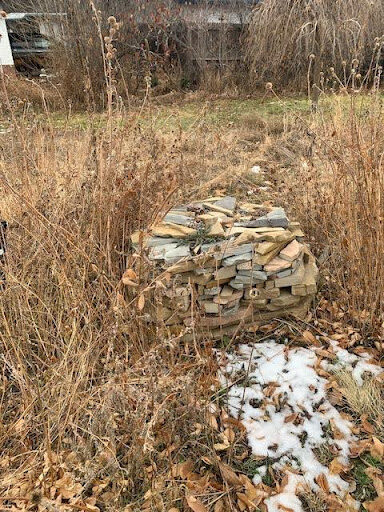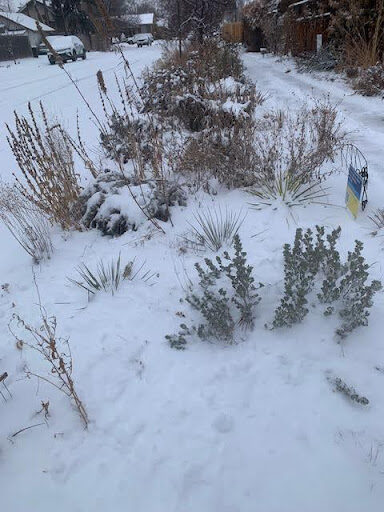By Deb Lebow Aal

In these semi-arid parts, at least half the year your garden will not be green. It will be brown, and red, and maybe yellow, and it can be gorgeous. The beauty of a winter garden can be in its structure, but also in its color. You just have to pay a little attention to details.

Seedpods and standing grasses, berries, and the silhouettes of trees, shrubs, and perennials, and the hardscape, can all be highlighted in the off season. And, many of our perennials have beautiful rosettes that last through the winter.

Strategically placed rocks and garden art play an important part in having some winter interest. And, if you’ve used pea gravel mulch, for the times when there is no snow on the ground, those areas can be stunning in the winter light. So, pay attention to both the plant and the non-plant parts of your garden for the winter display. Think about thinning and cleaning parts of the garden to help the winter interesting plants and art stand out.
Some of our favorite, easy-to-source native plants that will give your landscape some pizzazz in winter, in no particular order, are:
Winterfat (Krascheninnikovia lanata) has these seedheads that are puffs of white that look like cotton on the ends of its stems. So beautiful! This overlooked plant provides food for many bird species, and stays upright throughout the winter.
Switchgrass (Panicum virgatum) This grass doesn’t seem to get squished with snow, so its beautiful wheat color stands out in contrast to the snow
Sulphur buckwheat (Eriogonum umbellatum) A groundcover that turns red in the fall, and its rosette – the leaves near the ground – stay that way till greening up in the spring. A lovely red addition to the landscape.
Mahonia (or Berberis) repens: This low-growing groundcover, has four season interest, with winter perhaps being best. The leaves turn a purplish red in winter, if planted in the sun, and cover/protect the ground. In the shade, they stay green, which is welcome also in the winter.
Yuccas: all of them! With their spiky leaves, they look most beautiful with snow on the ground.

Western sage (Artemisia tridentata): stays that beautiful sage green all year.
Our native roses, e.g., Rosa Woodsii: The bright red rose hips stay on the plant through fall and winter. The stems and thorns turn a purplish color, adding a dash of purple to the winter scene. I happen to like its habit – a bit wild looking.
Rabbitbrush (Ericameria nauseosa): A sprawling, not very neat look, but eye-catching.

Prickly Pear (The Opuntias) The pods often turn a deep purple and shrivel in the winter, so that they aren’t damaged by frost, but they still look great sticking their pods out through snow. Some prefer the barrel cacti, Echinocereus and others, to Opuntia, for winter spiky interest.
Oaks (Quercus): Oaks of course keep their leaves until very late in the winter season, so add a brownish look to the design.
And, of course the evergreens – pines, junipers, and spruces. As long as they are located correctly in your landscape, these are the backbone to any winter interest. The conifers, combined with some architectural shrubs can make your winter. Rhus Glabra and Forestiera neomexicana are two lovely shrubs with winter interest. Remember the color wheel when placing your plants – placing persistent red foliage next to the green or blue green of conifers can make a striking statement.
Some of us need that winter break to refuel our gardening desire. But others are pining to get out there. When your landscape is not blanketed by snow, you can be crushing up leaves to use as mulch, working on hardscape, and communing with what wildlife is out there. I even move some plants around, when the ground is not frozen solid, and they survive! Keep it looking interesting in the winter and enjoy some time in your winter garden.
Curious to learn more about transforming your garden into a habitat with Colorado native wildflowers, grasses, shrubs, and trees? Check out our native gardening toolkit, register for an upcoming event, subscribe to our newsletter, and/or become a member – if you’re not one already!
